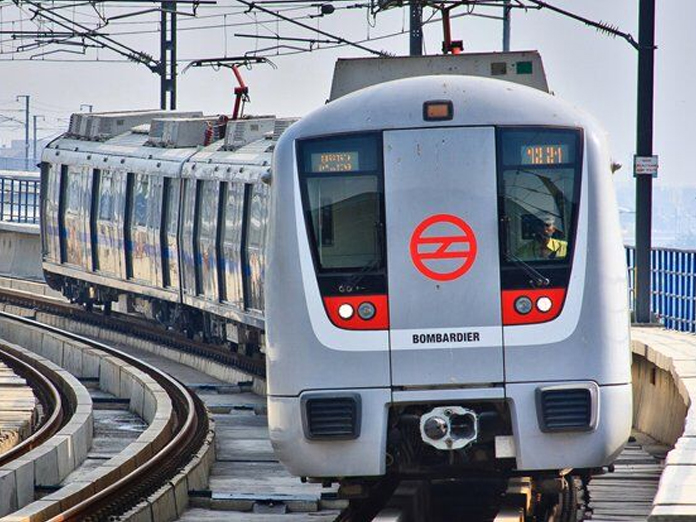2018 full of ‘vantage points’ and ‘tunnels’ for Delhi Metro

Delhi Metro, the capitals lifeline, shrunk distances and achieved milestones with the opening of seven sections, including its smallest and deepest stations in the year gone by, as it zoomed into a select club of Metros globally
New Delhi: Delhi Metro, the capital's lifeline, shrunk distances and achieved milestones with the opening of seven sections, including its smallest and deepest stations in the year gone by, as it zoomed into a select club of Metros globally.
The last section made operational in 2018 on its last day -- the 9.7-km Lajpat Nagar-Mayur Vihar Pocket 1 corridor of the Pink Line, directly connected south and east Delhi on the rapid transit network, taking the total operational length to 327 km with 236 stations.
However, it was the opening of the fifth corridor in 2018, in October -- the 17.8-km Shiv Vihar-Trilokpuri Sanjay Lake section of the Pink Line -- that brought the proud moment for the city Metro, as it puts Delhi among a select group of cities such as London, Beijing and Shanghai that have an operational Metro network of over 300-km.
The year 2018 also saw Delhi Metro and its riders literally reaching dizzying heights, giving passengers a bird's eye view of the sprawling city from a vantage point as high as the top of a seven-storeyed building.
The feat was achieved as part of the opening of the over 20 km-long Majlis Park- Durgabai Deshmukh South Campus corridor of the Pink Line, connected the north and south campuses of the Delhi University for the first time, on to the Metro network.
Rising at 23.6 m in busy Dhaula Kaun area, this scaled the highest point in the network of the mass rapid transit system that has shrunk distances and connected heart of the city to nondescript locations.
But it wasn't the only highest point that Delhi Metro reached in 2018, but also in an engineering accomplishment, which also built its deepest station on a new 24.82-km Magenta Line corridor spanning Kalakaji Mandir and Janakpuri West, which was opened in May.
At 29 metre, the five-level new Hauz Khas Station on the Magenta Line became the deepest station on the Delhi Metro network, whose tunnel was bored below the existing one on the Yellow Line. The old station at busy Hauz Khas (HUDA City Centre-Samayapur Badli or Yellow Line) is 17 m deep.
For the construction of the new station, it was not possible to go below the existing station, as the foundation is 32 metre and there is the foundation of the flyover on Outer Ring Road also, a senior DMRC official said.
At the inauguration of the Lajpat Nagar-Mayur Vihar Pocket 1 corridor of the Pink Line on December 31, Union Minister of State (Independent Charge) for Housing and Urban Affairs, Hardeep Singh Puri had lauded the Metro, saying, "This is the seventh time, operation of a metro line is being commenced in 2018, which is truly a great achievement.
The work on the Phase-III of the DMRC has been almost completed with nearly 96 km of it being made operational in 2018." This new segment is part of the 59-km-long Pink Line, which spans from Majlis Park to Shiv Vihar, the longest, among all the Metro lines in Delhi.
Only a 1.4-km stretch between Mayur Vihar Pocket-1 and Trilokpuri Sanjay Lake Stations of the Pink Line remain to be linked, which is likely to be completed in 2019.
In constructing the Lajpat Nagar-Mayur Vihar Pocket 1, Delhi Metro faced several challenges but surmounted them with innovation, as in building the Ashram Metro Station, in the area, which faced terrible traffic snarls. DMRC's Managing Director Mangu Singh said the work on Lajpat Nagar-Mayur Vihar Pocket 1 corridor faced several challenges, especially the Ashram and Hazrat Nizamuddin stations.
"The original design of Ashram station was changed due to constraints, and the new station box was kept at a length of 151 m and mezzanine was added to this station to accommodate facilities.
Ashram station is now the smallest station on the Delhi Metro network, and a regular station length is about 265 m," a senior DMRC official said.
In 2019, a few more lines are likely to be opened early, as Singh said, the nearly 30 km-long Noida-Greater Noida line is ready and could be inaugurated anytime soon, adding, Dilshad Garden-New Bus Adda section is also ready.
He said 2019 will also see focus on Phase-IV of the DMRC, which the Delhi government approved in December, with Chief Minister Arvind Kejriwal saying, it would boost public transport and reduce pollution. The Centre is examining the proposal for Phase-IV of Delhi Metro after it was forwarded by the city government in the last week of December, Parliament was informed on January 3.
Among the projects chosen under Phase IV are: Rithala-Bawana-Narela (21.73 km, elevated), Janakpuri West-RK Ashram (28.92 km, 21.18-km elevated), Mukundpur-Maujpur (12.54 km, elevated), Inderlok-Indraprastha (12.58 km, underground), Aero City-Tughlakabad (20.2 km, 5.58-km elevated), Lajpat Nagar-Saket G Block (7.96 km, 5.89-km elevated). The construction work under the project is estimated to cost around Rs 45,000 crore.







